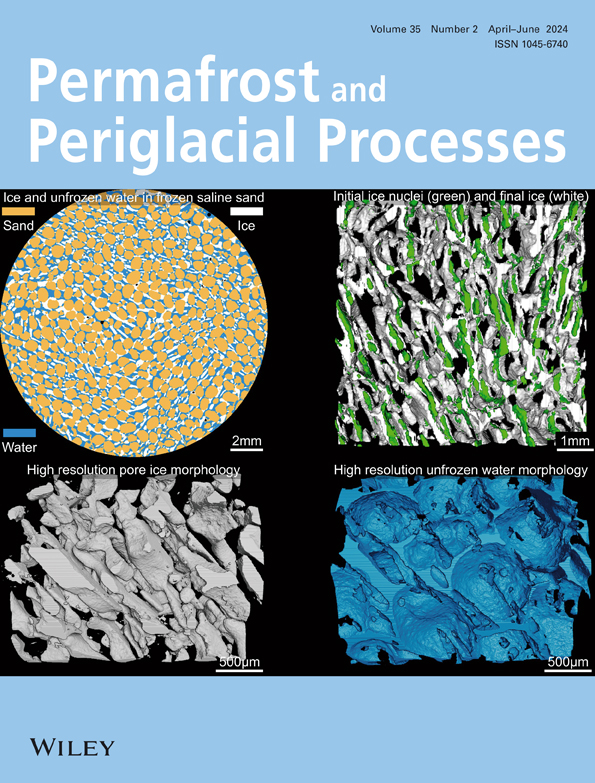结合历史和现代数据,解读奥地利Kaunertal InnereÖlgruben岩石冰川近一个世纪(1922–2021)的地貌演变
IF 3.3
3区 地球科学
Q2 GEOGRAPHY, PHYSICAL
引用次数: 3
摘要
岩石冰川是高山中低温条件下的下坡爬行地貌。由于受气候变化影响的外部因素,它们的动态正在发生变化。尽管近年来对山地永久冻土和岩石冰川的科学兴趣日益浓厚,但它们的历史发展,特别是在20世纪50年代第一次全高山航空图像飞行之前,几乎没有研究过。因此,我们利用1922年的历史立体摄影测量图和历史流速剖面(1938-1953),并将它们与1953年至2021年的几个时间片的历史航空照片和机载激光扫描数据相关联。通过这样做,分析和比较了近一个世纪以来奥地利考纳塔尔(Kaunertal)的复合岩石冰川Inner Ölgrube的流速发展、地表高程变化和两个裂片的锋面推进。结果表明,1922 ~ 1953年间,一个叶的侧限区锋面推进增加,两个叶的上部区域严重下沉。前者可以用20世纪40年代和50年代的短暂暖期和(地下)地形的结合来解释,后者可能归因于叠加碎屑覆盖的死冰体的强烈融化,这是小冰期(LIA)冰川的遗迹。这两个因素也可能对1938年至1953年间的流速增加有所贡献,这在1953年至1970年的时间步长中仍然可以识别。尽管这两个裂片在总体上遵循相似的趋势,这与20世纪90年代高山范围内流速加速的趋势一致,但两个裂片在地貌发育上存在差异。除了流速的演变略有不同外,体积变化的时间和幅度也有所不同。此外,在整个研究期间,两个脑叶表现出不同的额叶前进机制。由于外部强迫是相同的,不同的发展可能归因于内部结构、基岩地形或裂片上坡连接的变化。由于冰川的侧向收缩、地下地形和LIA最大程度,我们认为内Ölgruben岩石冰川的地貌发育,特别是1953年以前,是一个特例,其结果不能简单地转移到其他岩石冰川。本文章由计算机程序翻译,如有差异,请以英文原文为准。
Combination of historical and modern data to decipher the geomorphic evolution of the Innere Ölgruben rock glacier, Kaunertal, Austria, over almost a century (1922–2021)
Rock glaciers are cryo‐conditioned downslope‐creeping landforms in high mountains. Their dynamics are changing due to external factors influenced by climate change. Although there has been a growing scientific interest in mountain permafrost and thus in rock glaciers in recent years, their historical development, especially before the first alpine‐wide aerial image flights in the 1950s, has hardly been researched. Therefore, we utilize a historical stereophotogrammetric map from 1922 and historical flow velocity profiles (1938–1953) and relate them to data derived from historical aerial photographs and airborne laser scanning data in several time slices between 1953 and 2021. By doing so, the development of flow velocity, surface elevation changes, and frontal advance of the two lobes of the composite rock glacier Inner Ölgrube, Kaunertal, Austria, is analyzed and compared over almost a century. Results indicate an increased frontal advance in the laterally confined area of one lobe and a severe subsidence in the upper area of both lobes between 1922 and 1953. Whereas the former could be explained by a combination of the short warm phase in the 1940s and 1950s and the (subsurface) topography, the latter might be attributed to the strong melting of superimposed debris‐covered dead ice bodies, a relict of the Little Ice Age (LIA) glaciation. Both factors might also contribute to the increased flow velocities between 1938 and 1953, which are still recognizable in the 1953–1970 time step. Although both lobes follow a general similar trend, which is in line with the alpine‐wide trend of flow velocity acceleration in the 1990s, differences in the geomorphic development of the two lobes were identified. In addition to a slightly varying evolution of the flow velocities, the timing and magnitude of the volume changes are different. Furthermore, both lobes display a dissimilar mechanism of frontal advance over the entire study period. Because the external forcing is identical, the varying development might be attributed to variations in internal structure, bedrock topography, or upslope connection of the lobes. Due to the lateral constriction, the subsurface topography, and the LIA maximum extent of the glacier, it is assumed that the geomorphic development of the Innere Ölgruben rock glacier, particularly before 1953, represents a special case, and the results are not simply transferable to other rock glaciers.
求助全文
通过发布文献求助,成功后即可免费获取论文全文。
去求助
来源期刊
CiteScore
9.70
自引率
8.00%
发文量
43
审稿时长
>12 weeks
期刊介绍:
Permafrost and Periglacial Processes is an international journal dedicated to the rapid publication of scientific and technical papers concerned with earth surface cryogenic processes, landforms and sediments present in a variety of (Sub) Arctic, Antarctic and High Mountain environments. It provides an efficient vehicle of communication amongst those with an interest in the cold, non-glacial geosciences. The focus is on (1) original research based on geomorphological, hydrological, sedimentological, geotechnical and engineering aspects of these areas and (2) original research carried out upon relict features where the objective has been to reconstruct the nature of the processes and/or palaeoenvironments which gave rise to these features, as opposed to purely stratigraphical considerations. The journal also publishes short communications, reviews, discussions and book reviews. The high scientific standard, interdisciplinary character and worldwide representation of PPP are maintained by regional editorial support and a rigorous refereeing system.

 求助内容:
求助内容: 应助结果提醒方式:
应助结果提醒方式:


